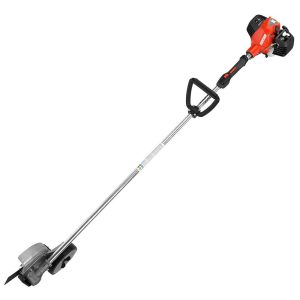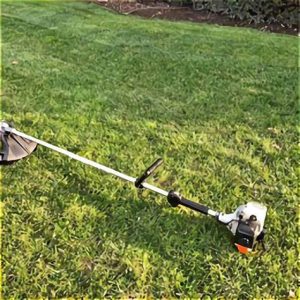Your ECHO Edger’s Noisy (8 Causes)
When the edger’s motor slows down, you won’t have the torque to move the blade and make a clean cut.
Issues with the carburetor, fuel line, fuel filter, spark plug, fuel tank vent, air filter, spark arrestor screen, and/or gasoline quality can all contribute to a rough-running ECHO edger.
Always exercise caution when dealing with your edger. Always use the ECHO in accordance with the manual’s recommended safety procedures. Removing the spark plug wire, waiting for the engine to cool, and stopping all motion are all necessary steps.
 When troubleshooting, repairing, or using a piece of equipment, be sure to first read and follow any safety recommendations found in the manual.If you are unsure about how to proceed or if you lack the necessary expertise or experience, you should seek the assistance of a professional.
When troubleshooting, repairing, or using a piece of equipment, be sure to first read and follow any safety recommendations found in the manual.If you are unsure about how to proceed or if you lack the necessary expertise or experience, you should seek the assistance of a professional.
Table of Contents
8 Causes Of Your ECHO Edger’s Poor Performance
Using stale gas in an ECHO Edger
When an ECHO edger starts to sputter and bog down, the quality of the gasoline is the first thing I look at. After only 30 days, the efficiency of your newly purchased fuel may start to degrade.
Ethanol, a plant-based fuel included in most gasoline, is known to attract moisture to the fuel system. Gummy residue and varnish are left behind after the ethanol and water solution evaporates.
Edger performance will suffer due to the varnish and deposits’ effect on fuel flow.
Good performance from your edger depends on the sort of fuel you use and how rapidly it is spent. Choosing the right fuel and taking good care of it can help prevent issues that arise from using stale gas.
You definitely don’t want to make a mistake when it comes to filling the petrol tank. If you don’t use the appropriate kind of gas or if the gas in your edger has been sitting about for a while, it can damage your edger.
When choosing fuel for your ECHO edger, keep the following in mind:
- Get new unleaded gas with an octane value of 89 or higher and no more than 10% ethanol added.
- ECHO edger 2-cycle engines require a 50:1 mixture of gas and 2-cycle oil mix before being refueled.
- Within 30 days, all gasoline must be used.
- If you won’t be using the fuel within 30 days, you can extend its life by mixing in a fuel stabilizer.
- Keep fuel in a cool, dry place away from anything that could catch fire.
The ANSWER is to flush the tank of any stale gas. In a gas can, combine 50 percent unleaded gasoline with 1 percent 2-cycle oil. Sea Foam Motor Treatment is a gasoline additive that can clean the fuel system and keep the fuel stable.
Put the fuel mixture in the gas tank and let the car run for a while to let the new gasoline circulate. Possible improvement in ECHO edger performance.
If not, continue down the list to see if anything else catches your eye.
ECHO Edger with a Clogged Fuel Filter
Keep looking for potential sources of fuel restriction and fixing them one by one. Take a look at the fuel filter. You’ll find this tiny cylinder hooked to the fuel line inside the fuel tank.
Failure to replace the filter on a regular basis can prevent clean fuel from reaching the carburetor. The edger’s performance will suffer as a result.
The following steps outline how to replace a clogged ECHO fuel filter:
- Place the edger in a level position.
- Remove the gasoline cap, wipe it down, and replace it.
- With the help of a clean, bent wire, remove the fuel filter from the tank.
- Holding the fuel line firmly, remove the filter by pulling it straight out.
- Put in a fresh fuel filter at the fuel tank’s end.
- Reinstall the fuel filter inside the tank.
ECHO Edger with a Clogged Fuel Line
Check the gasoline line for any obstructions or kinks that might be preventing fuel from flowing freely. Fuel that is filthy or old fuel that has left sticky deposits might cause blockages.
The ANSWER to a clogged, kinked, punctured, or leaking ECHO line is a whole new gasoline line.
An ECHO Edger’s Filthy Carburetor
The carburetor controls the ratio of fuel to air for combustion, allowing the ECHO to turn over and run.
If the fuel-to-air ratio is off, the edger may vibrate or stall. Carburetors have narrow pathways and the tiny parts that build them up are prone to sticking.
Because of this, the ECHO carburetor may stop working properly and not supply the engine with adequate gasoline.
The carburetor could only need to be cleaned to restore normal operation. If carburetor cleaning doesn’t help, you may need to repair (if rebuild kits are available for your carburetor) or substitute it.
Carburetors often break when contaminated fuel is pumped through them.
Using new fuel will save wear and tear on the carburetor. If you want to keep your carburetor in good working order, you should switch to a fuel that doesn’t include ethanol, such as ECHO Red Armor 50:1 fuel.
Unclean ECHO Edger Spark Plug
Your ECHO can misfire and operate poorly if its spark plug is dirty. Your edger may not be running properly if the spark plug is damaged, the spark plug spacing is off, or the spark plug wire is loosened.
Use a socket wrench to take out the spark plug. See how it is doing. If the spark plug’s tip is very dark, the porcelain is fractured, or the electrode is burned, you should replace it.
If the spark plug is otherwise functional but dusty, you can either cleanse it with a wire brush or substitute it.
Using a feeler gauge, verify that the spark plug gap satisfies the criteria set forth by the engine manufacturer. Put in a new spark plug, or clean the one you have. Verify the spark plug wire is properly connected.
ECHO Edger with Blocked Fuel Tank Vent
There must be a hole in the fuel tank for air to circulate. If the fuel tank vacuum forms because this vent is blocked, the fuel will not reach the carburetor.
On an ECHO edger, the fuel tank vent is a discrete component at the terminus of the fuel delivery line. If the fuel tank vent is blocked, the engine will sputter and stall.
If the gasoline pump isn’t working and there isn’t a blockage in the fuel line, the fuel filter, or the carburetor, the fuel tank vent may be clogged.
The gasoline cap can be loosened to allow air into the tank to check for a blocked vent. Get the edger going and leave it alone. Carefully avoid leaking gas by keeping the edger on a level surface.
If your ECHO edger is running smoothly without stalling or running rough, tighten the fuel cap and observe if the problem persists.
If your edger continues to act up and run rough after you’ve replaced the fuel cap, the fuel tank vent may need to be replaced. If the fuel tank is unable to vent, it is because of the filter and check valve contained in the cap, both of which are non-serviceable.
Air Filter Clogged on an ECHO Edger
If you want to power on your ECHO edger, you’ll need an air filter. It safeguards the engine by preventing debris from entering the air intake.
If you don’t inspect, clean, and replace your edger’s air filter regularly, it might get so clogged with dirt that not enough air can pass through it.
The engine will start to sputter if it doesn’t get enough air. Maintaining clean air is crucial to preventing engine overheating and malfunction.
Check the air filter and cleanse it according to the instructions below if it is in good condition. A new filter should be installed if the old one is severely clogged, broken, or covered in fuel.
How to cleanse a felt-type air filter on an ECHO edger:
- Take off the housing’s cover for the air filter.
- Use a dry, clean cloth to wipe out any lingering dirt in the housing, then cover it up. Take cautious not to let any debris or dirt enter the air intake.
- Have the filter checked. You can clean the filter if it’s not broken, soaked with gas, or too grimy.
- Brush the dust and debris off the air filter. After a light brushing, try washing the filter in a solution of mild detergent and water if it still doesn’t function. Gently remove the grime from the filter. The filter needs to dry out entirely, so let it air out.
- Put the air filter back in place.
- The air filter cover must be reattached.
Due to the wide variety of ECHO models and air filter types, each model’s handbook should be consulted for specific instructions on how to clean the air filter.
ECHO Edger with a Blocked Spark Arrestor
To prevent burns or fires from occurring if hot exhaust material were to shoot out of an ECHO edger, a small metal screen is mounted to the muffler.
When carbon deposits clog this tiny screen, engine performance suffers.
The spark plug wire needs to be disconnected. Take off the hood and the exhaust cover. Using a metal brush, carefully take off the spark arrestor screen.
Replace the dirty screen with a new, clean one. The engine cover and the exhaust cover must be reattached. Connect the wire back to the spark plug.
A new spark arrestor screen must be installed if the old one can’t be cleaned properly or is found to be broken or to have a hole in it.







